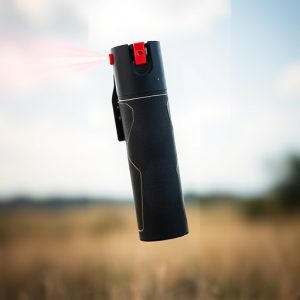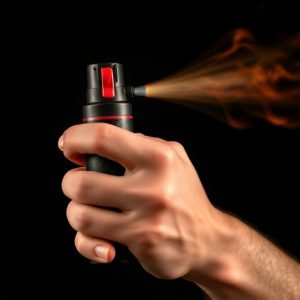Protecting Yourself: Managing Expired Chemical Irritants & Non-Chemical Alternatives
Chemical irritants in pepper spray help protect individuals but require responsible disposal to prev…….
Chemical irritants in pepper spray help protect individuals but require responsible disposal to prevent environmental and health risks. Expired pepper spray can still be dangerous, so identify its reduced effectiveness, texture or color changes, and altered scent. Dispose of it properly by following local guidelines for hazardous waste, avoiding regular trash to protect water sources and wildlife. Familiarize yourself with alternative personal protective devices (PPDs) and proper disposal methods for expired chemical irritants to promote safety and sustainability.
Personal protection devices, such as pepper spray, are essential tools for safety. However, understanding the chemistry behind these irritants is crucial for their effectiveness and safe handling. This article delves into the world of chemical irritants, exploring their role in personal protection. We’ll guide you through identifying expired pepper spray, proper disposal methods, and even present alternative non-chemical protective solutions. Learn how to navigate this topic, especially when it comes to disposing of expired pepper spray, a vital step for maintaining safety and environmental responsibility.
- Understanding Chemical Irritants and Their Role in Personal Protection
- Identifying Expired Pepper Spray: Signs and Symptoms
- Safe Disposal Methods for Expired Pepper Spray
- Alternative Solutions: Exploring Non-Chemical Personal Protective Devices
Understanding Chemical Irritants and Their Role in Personal Protection
Chemical irritants play a pivotal role in personal protection devices, designed to cause temporary discomfort or disability in potential aggressors. These substances are often used in pepper spray, a common self-defence tool. When deployed, they disrupt vision and breathing, giving users precious time to escape dangerous situations. Understanding the science behind these irritants is crucial for effective deployment and safety.
Among commonly used chemical irritants, capsaicin, the active ingredient in chili peppers, and oleoresin capsicum (OC) are popular choices. OC pepper spray is highly effective, causing irritation through its complex mixture of chemicals. Proper usage involves aiming for the eyes and face, where sensitive nerve endings amplify the irritant’s effect. However, it’s essential to dispose of expired pepper spray responsibly, following local guidelines, especially considering how to dispose of expired pepper spray to prevent environmental and health hazards.
Identifying Expired Pepper Spray: Signs and Symptoms
Expired pepper spray can still cause serious irritation, so it’s crucial to know how to identify it. One of the most noticeable signs is its effectiveness—if your pepper spray has expired, it won’t work as intended when deployed. Other visual cues include a change in texture or color, such as cracking, leaking, or fading of the canister. The scent is another indicator; fresh pepper spray has a strong, pungent odor, while an old one may have lost its characteristic smell or emit a faint, off-putting aroma.
When dealing with expired pepper spray, proper disposal is essential to prevent any potential harm. Start by removing it from its original packaging and disposing of that material responsibly. Pepper spray should not be mixed with regular trash due to its active ingredients and the potential for environmental contamination. Instead, check local regulations for hazardous waste collection programs or specialized facilities that can handle such items safely. Always prioritize safety when getting rid of expired pepper spray to ensure it doesn’t fall into the wrong hands.
Safe Disposal Methods for Expired Pepper Spray
To ensure safety and prevent environmental contamination, proper disposal methods for expired pepper spray are essential. Start by checking local regulations regarding hazardous waste disposal, as guidelines may vary depending on your location. Many areas require specific collection points or specialized facilities to handle such items safely.
One recommended method is to place the empty pepper spray container in a sealed plastic bag and store it in a secure area until collection events are organized by local authorities or waste management companies. Never dispose of pepper spray down the drain or in regular trash, as this can cause harm to water sources and wildlife.
Alternative Solutions: Exploring Non-Chemical Personal Protective Devices
In recent years, there has been a growing interest in exploring alternative solutions for personal protective devices that go beyond traditional chemical irritants like pepper spray. While pepper spray has long been a popular choice for self-defense due to its effectiveness in temporarily disabling attackers, concerns about misuse, off-target effects, and environmental impact have prompted researchers and manufacturers to seek safer alternatives.
Non-chemical personal protective devices offer promising options with minimal health risks. For instance, electronic stun guns, tasers, and sound-based deterrents like high-decibel alarms can effectively startle and incapacitate assailants without relying on chemicals. Additionally, innovative designs such as smart body armor equipped with sensors and advanced materials can provide enhanced protection while ensuring comfort and ease of use. Furthermore, proper disposal methods for expired pepper spray are crucial, involving specific guidelines to prevent environmental contamination and ensure the safety of waste management personnel. Learn how to responsibly dispose expired pepper spray according to local regulations to promote a safer, more sustainable approach to personal protection.
In conclusion, understanding chemical irritants, their functionality in personal protection, and recognizing expired pepper spray are vital steps towards ensuring safety. Proper disposal methods, as outlined in this article, including how to dispose of expired pepper spray, are essential practices to maintain the effectiveness of your protective devices. Additionally, exploring alternative non-chemical options broadens our capabilities for self-defense, offering diverse and innovative personal protective solutions.


